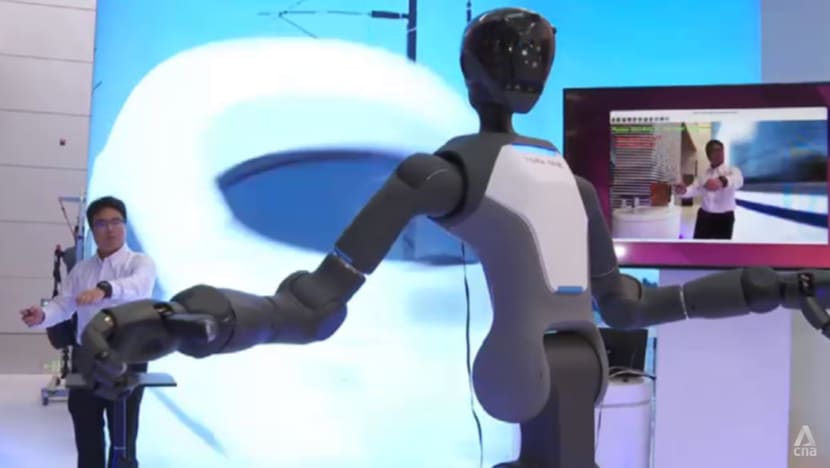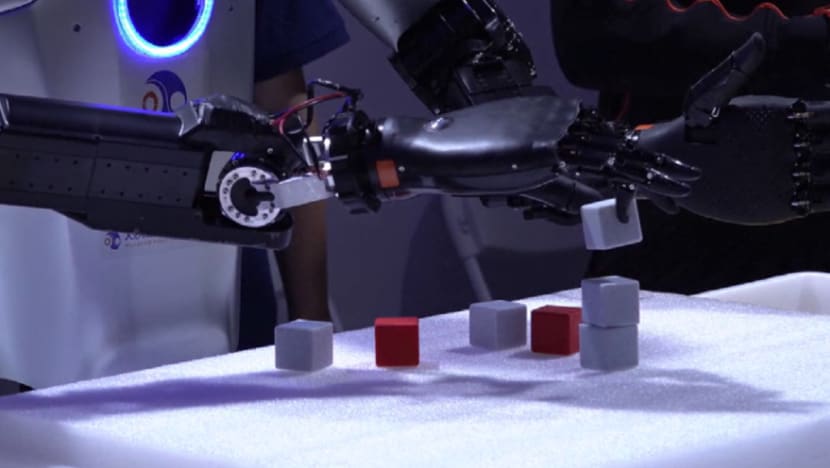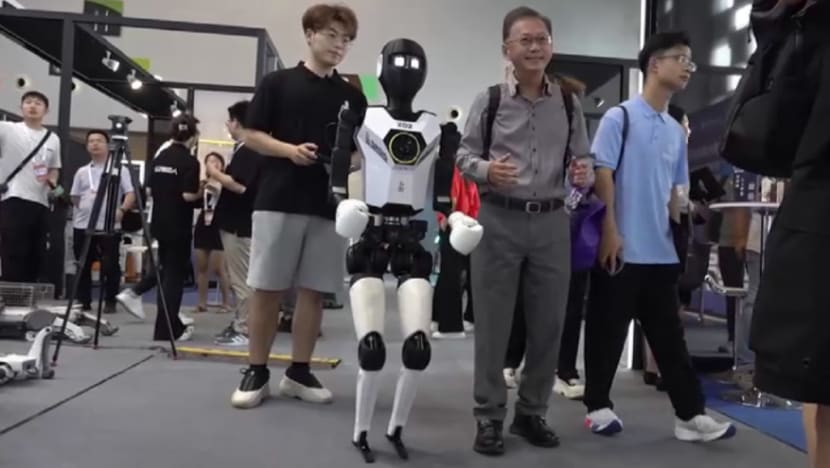Artificial intelligence’s adoption and regulation in focus at WEF’s Summer Davos
World leaders want to move beyond theory and towards more real-world adoption of AI, but experts say challenges stand in the way of widening implementation.

A humanoid robot mimics an attendee's arm movements at the WEF's Summer Davos in Tianjin, China.

This audio is generated by an AI tool.
TIANJIN: At the World Economic Forum’s (WEF) Summer Davos in the northern Chinese city of Tianjin, the familiar gathering of academics and business leaders featured a newer presence: robots.
Handshakes were shared between participants and humanoid machines as participants watched robotic fingers mimic their gestures with uncanny precision.
Though tucked into a small exhibit, these interactions echoed one of the forum’s biggest themes – how artificial intelligence is rapidly reshaping daily life and transforming industries.
For instance, the AI-powered robotic hands are already helping doctors in surgery. They may also one day provide advanced prosthetics to replace missing body parts.
With such swift advances, AI is among topics being discussed at the WEF multilateral gathering officially known as the Annual Meeting of the New Champions.
AI & CLIMATE CRISIS
A key focus is AI’s predictive potential in tackling the climate crisis.
Advocates have emphasised the urgency to scale up renewable energy as the planet gets warmer year after year. Last year was the hottest year on record.
Experts at the meeting are discussing how AI can accelerate the energy transition, such as managing energy use and demand, and using predictive capabilities to help governments prioritise projects in the future.
However, industry players warn that momentum could stall, with financial and geopolitical concerns bringing competing priorities.
“The biggest constraint is resources for any country, especially in a very geopolitically tense world where every country is prioritising spending on defence,” said Himanshu Gupta, co-founder and CEO of ClimateAi, a firm which uses AI to help clients manage climate-related risks.
AI itself is also contributing to the energy demand. It needs powerful processors to train and run, with data centres requiring constant power and generating immense heat. Both the computing and the cooling processes guzzle massive amounts of electricity.
Still, experts said there is increased commitment to rebalance the global energy mix, with more funding flowing into sustainable systems, especially in Asia.
China, the world's leading producer of clean technologies, has also made the green transition cheaper and more accessible.
“It's a shifting landscape for sustainability, climate and energy. We're not stopping on energy transition because … we need to leave (future generations) with the right kind of resources,” said Agnes Tai, director of Great Glory Investment Corporation, a Hong Kong-based family office focused on sustainability.
AI RIVALRY AND ADOPTION
Discussions surrounding AI are also centred on moving beyond theory and towards real-world implementation across sectors including healthcare and manufacturing.
According to a recent WEF report, just 45 per cent of chief economists surveyed expect AI to become commercially disruptive this year.
One major roadblock is the shortage of workers equipped with the skills to work with AI.
However, experts said challenges stand in the way of widening and deepening adoption.
Despite falling costs, AI systems are not yet widely embedded across industries.

There is also a broader geopolitical issue – restrictions on advanced chips, especially from the United States, have further complicated progress in China, slowing down access to the types of AI hardware needed to train cutting-edge models.
The rivals – which make up the world’s two largest economies – are at the forefront of the global AI race.
But experts have said the battle for AI supremacy is not necessarily a zero-sum game.
“People are talking about how we need to achieve AI supremacy for data security, national security in order to achieve economic growth. But I don’t think that’s the case,” said Angela Zhang, a law professor at the University of Southern California.
“Everybody is trying to advance, it does not necessarily mean you have to get to the most cutting edge to create that explosive growth,” she told CNA.
“If we combine these two countries (the US and China) together, they will make the perfect team. Their skillsets are complementary.”
Others argue the restrictions have created space for greater innovation.
“Initially, founders in China were super worried because there's embargo on chips and the foundation model to China,” said Zhou Yuxiang, CEO of Black Lake Technologies.
“But DeepSeek is kind of a landmark event that made us realise we actually will be able to self-incubate a foundation model on a more cost efficient way, and also certain embargo will drive China or the rest of the world to incubate our own chips, our own foundation model, which is gradually happening now.”
DeepSeek’s release in January has simultaneously stirred awe and rattled nerves through the global tech sector. The Chinese model came hot on the heels of ChatGPT – at fraction of the cost – despite efforts to stifle AI progress in China.
LAGGING IN REGULATION
Another area of discussion in the rise of AI and its adoption is regulation – or the lack thereof. This involves establishing clear guidelines, ethical standards and legal frameworks to ensure that such technologies are developed and deployed responsibly.
A survey by Japanese infotech firm NTT Data showed over 80 per cent of respondents citing a lack of regulation in the industry as an impediment to investments.
“In the global landscape, certainly in Asia Pacific, there's a lot of regulatory hurdles,” said the company’s Asia Pacific CEO John Lombard. “We certainly think organisations need to consider the regulatory environment that they're operating in.”

However, industry leaders have said regulation not only creates safety parameters, but also grounds for innovation.
“If politics gets in the way, engineers and developers will find a different way to solve the problem,” said Darko Matovski, co-founder and CEO of software firm causaLens.
“I think that's actually really good for the field, we're going to get different ideas inspiring the different ecosystems. Competition is actually always healthy and is going to produce better results faster.”
Experts said greater investment in infrastructure and education will make AI more inclusive and accessible.
Despite the challenges, industry leaders say the key lies in reimagining AI’s role, allowing it to take over certain tasks, while humans concentrate on areas where they excel.
“We'll see new jobs developed off the back of AI. Many years ago, there were concerns about technology replacing jobs, but what we saw was new jobs created,” said Lombard.
“AI is there to augment us, to help us, not to replace us. We always need human involvement in all of these processes and activities.”















